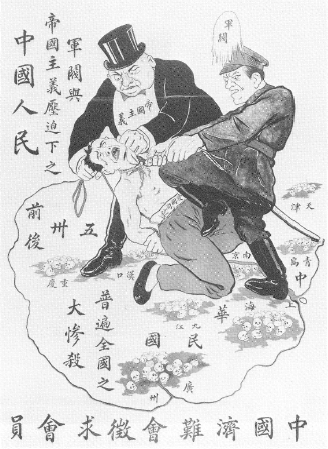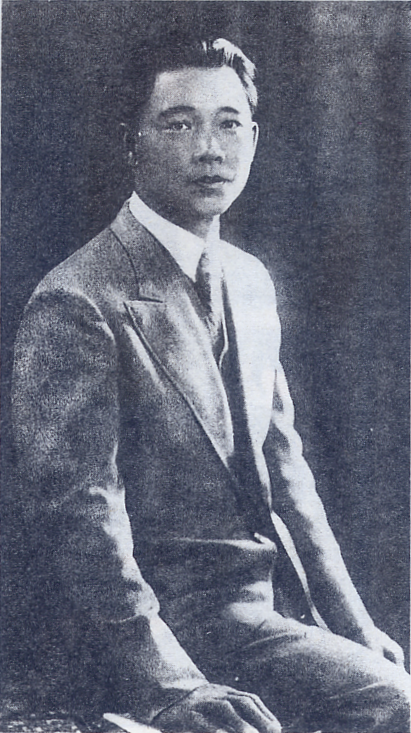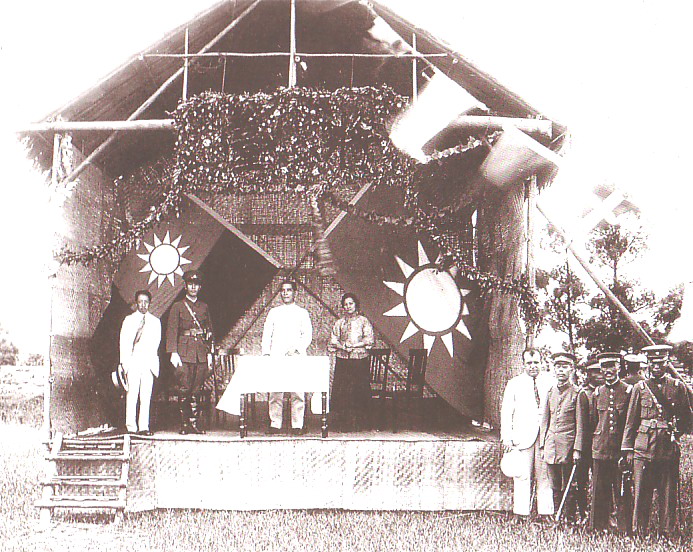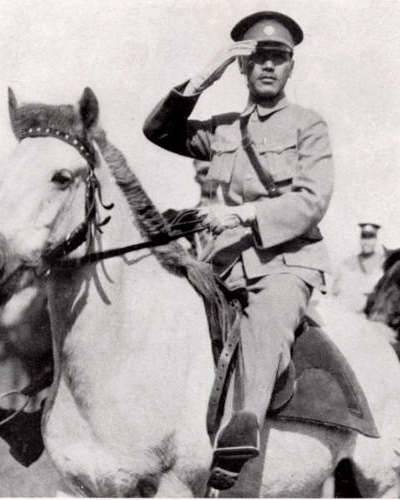|
Yun Daiying
Yun Daiying (August 12, 1895 – April 29, 1931) was an early leader of the Chinese Communist Party. Early life In 1913, Yun Daiying entered the private Zhonghua University in Wuchang, and after graduation in 1918, he stayed there as an instructor. In 1919, he participated in the May Fourth Movement in Wuhan. In 1920, he founded the Socialist Youth League of China with Xiao Chunü and others, and in 1921, he joined the Chinese Communist Party as one of the first batch of party members. In 1923, he became an instructor at Shanghai University. In Shanghai, he became a leader of the Communist Youth League of China and the chief editor of the periodical ''China Youth'' from 1925 to 1927. Political career In 1924, he joined under orders the Kuomintang ( First United Front), promoting cooperation between the Communist Party and the Kuomintang. In 1925, he led the May Thirtieth Movement in Shanghai. He went to the Whampoa Military Academy in Canton in 1926, where he bec ... [...More Info...] [...Related Items...] OR: [Wikipedia] [Google] [Baidu] |
Wuchang District
Wuchang is one of 13 urban districts of the prefecture-level city of Wuhan, the capital of Hubei Province, China. It is the oldest of the three cities that merged into modern-day Wuhan, and stood on the right (southeastern) bank of the Yangtze River, opposite the mouth of the Han River. The two other cities, Hanyang and Hankou, were on the left (northwestern) bank, separated from each other by the Han River. The name "Wuchang" remains in common use for the part of urban Wuhan south of the Yangtze River. Administratively, however, it is split between several districts of the City of Wuhan. The historic center of Wuchang lies within the modern Wuchang District, which has an area of and a population of 1,102,188. Other parts of what is colloquially known as Wuchang are within Hongshan District (south and south-east) and Qingshan District (north-east). Presently, on the right bank of the Yangtze, it borders the districts of Qingshan (for a very small section) to the north ... [...More Info...] [...Related Items...] OR: [Wikipedia] [Google] [Baidu] |
May Thirtieth Movement
The May Thirtieth Movement () was a major labor and anti-imperialist movement during the middle-period of the Republic of China era. It began when the Shanghai Municipal Police opened fire on Chinese protesters in Shanghai's International Settlement on 30 May 1925 (the Shanghai massacre of 1925). The shootings sparked international censure and nationwide anti-foreign demonstrations and riots such as the Hands Off China protests in the United Kingdom. Background In the aftermath of the 1924 Second Zhili–Fengtian War, China found itself in the midst of one of the most destructive periods of turmoil since 1911.Waldron, Arthur, (1991) ''From War to Nationalism: China's Turning Point'', p. 5. The war had involved every major urban area in China, and badly damaged the rural infrastructure. As a result of the conflict the Zhili-controlled government, backed by varied Euro-American business interests, was ousted from power by pro- Japanese warlord Zhang Zuolin, who installed a ... [...More Info...] [...Related Items...] OR: [Wikipedia] [Google] [Baidu] |
Gu Shunzhang
Gu Shunzhang (; 1903 – 1934), born Gu Fengming was an early leader, spymaster, and defector of the Chinese Communist Party (CCP). Sent to Soviet Russia to train in espionage, Gu was chosen by Zhou Enlai to lead the CCP's first intelligence service, the Central Special Branch (). After he was captured by the Kuomintang (KMT), Gu defected and revealed to the KMT intelligence all he knew of Zhou Enlai's underground communist spy network earning him a reputation as "the most dangerous traitor in the history of the CCP." Early in his life, Gu worked at Nanyang Tobacco Factory, where he became an active participant of workers' movement, then of the Shanghai Trade Union and finally of the CCP. In 1926 Gu was sent to the Soviet Union (Vladivostok) for training as a spy. After his return he participated thrice in the armed uprisings in Shanghai. In 1927, after the 12 April Incident, he became an active member of the underground communist movement together with Zhou Enlai, held nume ... [...More Info...] [...Related Items...] OR: [Wikipedia] [Google] [Baidu] |
6th Central Committee Of The Chinese Communist Party
The 6th Central Committee of the Chinese Communist Party was in session from 1928 to 1945, during most of the Chinese Civil War, and during the Second Sino-Japanese War. It held seven plenary sessions in this period. It was formally preceded by the 5th Central Committee of the Chinese Communist Party. It was the first central committee to have Mao Zedong as a high-ranking member. It was succeeded by the 7th Central Committee. 58 individuals served as members and 34 individuals as alternates. Its first plenary session elected the 6th Politburo of the Chinese Communist Party in Moscow in 1928, as it would not have been safe to have the session in the Republic of China. Chronology ''1st Plenary Session'' *Date: July 18, 1928 *Location: Moscow, USSR *Significance: The meeting was held in Moscow, as the 6th National Congress of the Chinese Communist Party was held there concurrently with the 6th Congress of the Comintern. Xiang Zhongfa was elected General Secretary under Li L ... [...More Info...] [...Related Items...] OR: [Wikipedia] [Google] [Baidu] |
Hong Kong
Hong Kong)., Legally Hong Kong, China in international treaties and organizations. is a special administrative region of China. With 7.5 million residents in a territory, Hong Kong is the fourth most densely populated region in the world. Hong Kong was established as a colony of the British Empire after the Qing dynasty ceded Hong Kong Island in 1841–1842 as a consequence of losing the First Opium War. The colony expanded to the Kowloon Peninsula in 1860 and was further extended when the United Kingdom obtained a 99-year lease of the New Territories in 1898. Hong Kong was occupied by Japan from 1941 to 1945 during World War II. The territory was handed over from the United Kingdom to China in 1997. Hong Kong maintains separate governing and economic systems from that of mainland China under the principle of one country, two systems. Originally a sparsely populated area of farming and fishing villages,. the territory is now one of the world's most signific ... [...More Info...] [...Related Items...] OR: [Wikipedia] [Google] [Baidu] |
Guangzhou Uprising
The Guangzhou Uprising, Canton Uprising or Canton Riots of 1927 was a failed communist uprising in the city of Guangzhou (Canton) in southern China. Background The Chinese Communist Party (CCP)'s Guangdong Provincial Committee had been preparing for an uprising in Guangzhou since September 1927. It originally planned to use a large group of communist-leaning soldiers who were heading into Guangdong after taking part in the failed Nanchang uprising. According to these plans, local workers and peasants were supposed to act as auxiliaries, while the soldiers would bear the brunt of the fighting. The troops from Nanchang were defeated at Shantou in early October, however, precluding any attempt to utilise them in the Guangzhou Uprising. CCP party head Qu Qiubai consequently decided that the communists had to persuade soldiers who were stationed in Guangdong to join their cause. Upon receiving orders from Joseph Stalin to launch the planned uprising in mid-December, over the ... [...More Info...] [...Related Items...] OR: [Wikipedia] [Google] [Baidu] |
Jiujiang
Jiujiang, formerly transliterated Kiukiang and Kew-Keang, is a prefecture-level city located on the southern shores of the Yangtze River in northwest Jiangxi Province in the People's Republic of China. It is the second-largest prefecture-level city in Jiangxi and its borders include Poyang Lake, the largest freshwater lakes of China, lake in China. Jiujiang is the fourth largest port on the Yangtze River and was one of the first five cities that were opened to foreign trade along the Yangtze River following the implementation of Deng Xiaoping's Opening-Up Policy. It is Jiangxi's only international trade port city. Its population was 4,600,276 inhabitants at the 2020 Chinese census, 2020 census, 1,164,268 of whom resided in the built-up area (metro) made up of three urban districts (aka Xunyang District, Xunyang, Lianxi District, Lianxi, and Chaisang District, Chaisang). In 2007, the city was named China's top ten livable cities by the Chinese Cities Brand Value Report, which was ... [...More Info...] [...Related Items...] OR: [Wikipedia] [Google] [Baidu] |
Wang Jingwei
Wang Zhaoming (4 May 188310 November 1944), widely known by his pen name Wang Jingwei, was a Chinese politician who was president of the Reorganized National Government of the Republic of China, a puppet state of the Empire of Japan. He was initially a member of the Socialist ideology of the Kuomintang, left wing of the Kuomintang (KMT), leading a Government of the Republic of China in Wuhan, government in Wuhan in opposition to the right-wing Nationalist government in Nanjing, but later became increasingly anti-communist after his efforts to collaborate with the Chinese Communist Party ended in political failure. Wang was a close associate of Sun Yat-sen for the last twenty years of Sun's life. After Sun's death in 1925, Wang engaged in a political struggle with Chiang Kai-shek for control over the Kuomintang, but lost. Wang remained inside the Kuomintang, but continued to have disagreements with Chiang. Following the outbreak of the Second Sino-Japanese War in 1937, Wang acce ... [...More Info...] [...Related Items...] OR: [Wikipedia] [Google] [Baidu] |
Republic Of China Military Academy
The Republic of China Military Academy ( zh, t=中華民國陸軍軍官學校, p=Zhōnghúa Mīngúo Lùjūn Jūnguān Xúexiào, poj=Tiong-hôa Bîn-kok Lio̍k-kun Kun-koaⁿ Ha̍k-hāu), also known as the Chinese Military Academy (CMA), is the service academy for the Republic of China Army. It was founded by the Republic of China as the Whampoa Military Academy at Huangpu (Whampoa), Guangzhou in 1924. At the end of the Chinese Civil War the academy evacuated to the island of Taiwan and took its current name. Its graduates participated in the Northern Expedition, the Second Sino-Japanese War and the Chinese Civil War. Establishment By 1924, the Kuomintang (KMT) wanted to build a modern, and politically reliable armed force. The KMT received money, materiel, and advisors from the Soviet Union; military advisors provided training and began reorganizing the KMT's forces along Soviet lines. As part of the reforms, political commissars were introduced for political and techn ... [...More Info...] [...Related Items...] OR: [Wikipedia] [Google] [Baidu] |
Northern Expedition
The Northern Expedition was a military campaign launched by the National Revolutionary Army (NRA) of the Kuomintang (KMT) against the Beiyang government and other regional warlords in 1926. The purpose of the campaign was to reunify China proper, China, which Warlord Era, had become fragmented in the aftermath of the 1911 Revolution. The expedition was led by Generalissimo Chiang Kai-shek, and was divided into two phases. The first phase ended in a 1927 political split between two factions of the KMT: the right-leaning Nanjing Nationalist government, faction, led by Chiang, and the Government of the Republic of China in Wuhan, left-leaning faction in Wuhan, led by Wang Jingwei. The split was partially motivated by Chiang's Shanghai massacre, Shanghai Massacre of Communists within the KMT, which marked the end of the First United Front. In an effort to mend this schism, Chiang Kai-shek stepped down as the commander of the NRA in August 1927, and went into exile in Japan. The sec ... [...More Info...] [...Related Items...] OR: [Wikipedia] [Google] [Baidu] |






